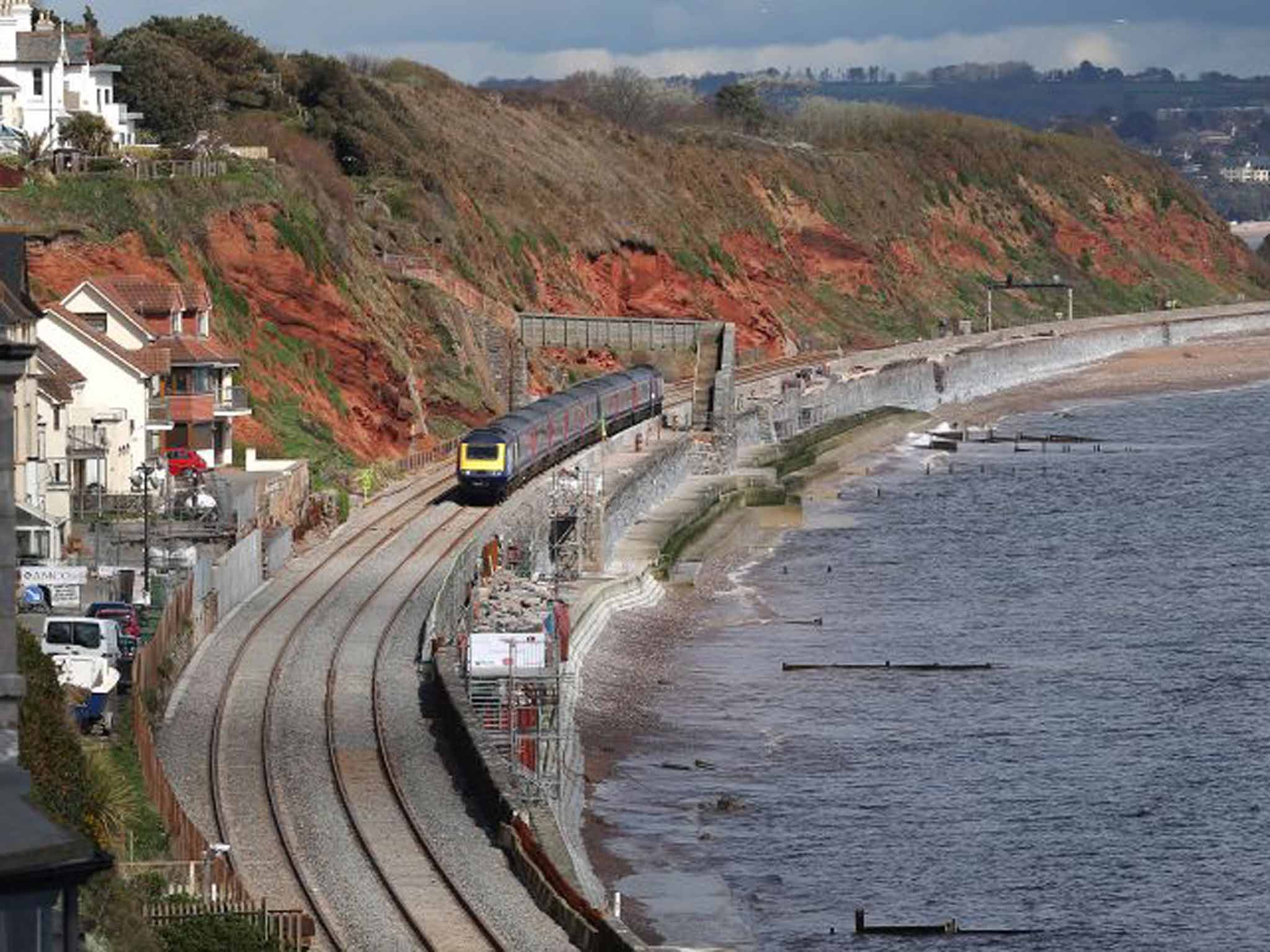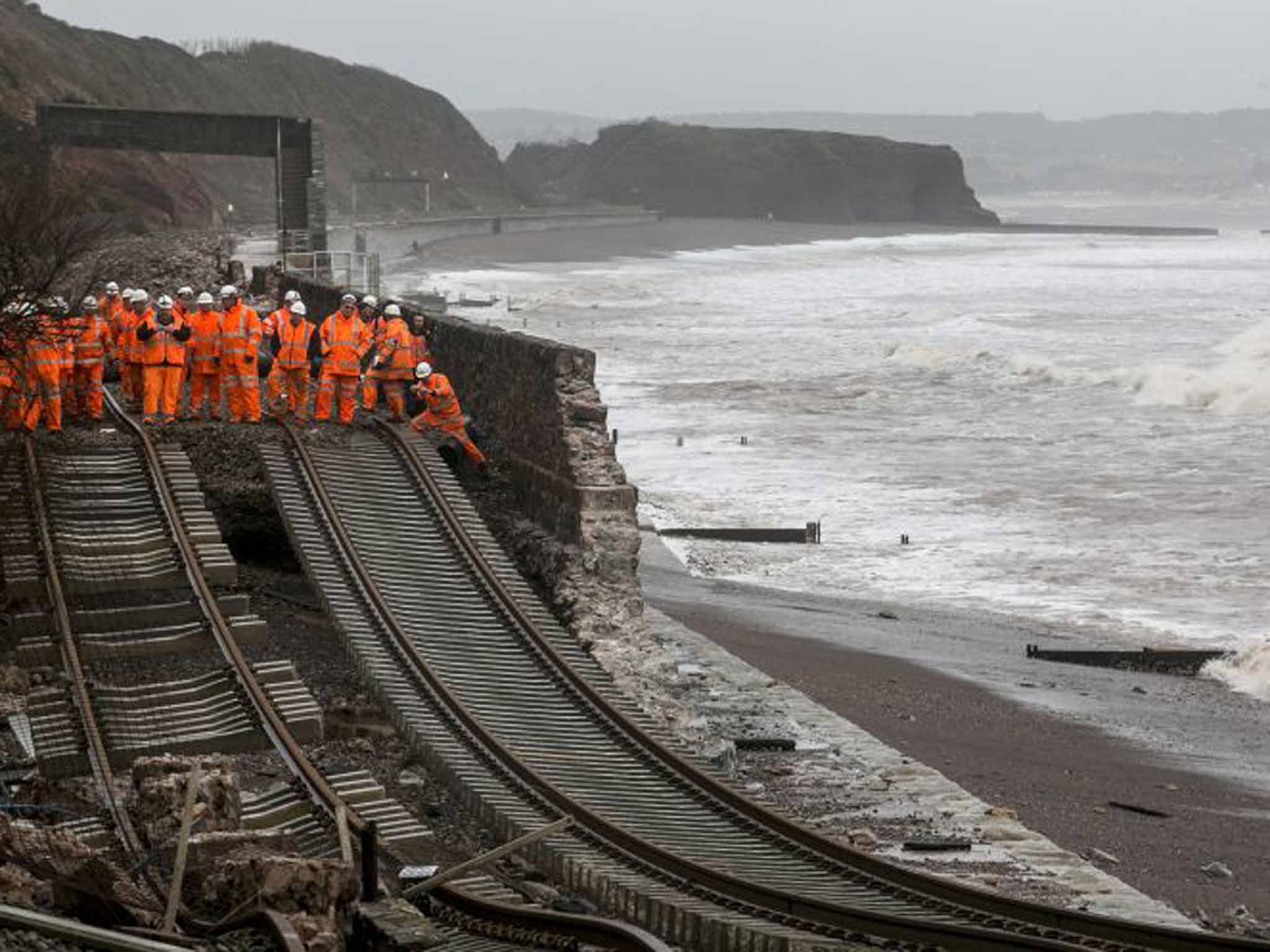Dawlish is back on track: The calm after the storm
One year ago the elements battered England, buckling the mainline railway that runs alongside this coastal Devon town

Your support helps us to tell the story
From reproductive rights to climate change to Big Tech, The Independent is on the ground when the story is developing. Whether it's investigating the financials of Elon Musk's pro-Trump PAC or producing our latest documentary, 'The A Word', which shines a light on the American women fighting for reproductive rights, we know how important it is to parse out the facts from the messaging.
At such a critical moment in US history, we need reporters on the ground. Your donation allows us to keep sending journalists to speak to both sides of the story.
The Independent is trusted by Americans across the entire political spectrum. And unlike many other quality news outlets, we choose not to lock Americans out of our reporting and analysis with paywalls. We believe quality journalism should be available to everyone, paid for by those who can afford it.
Your support makes all the difference.Last Friday, a clairvoyancy evening was held at Dawlish Christian Spiritualist Church in Albert Street in the South Devon resort. I couldn't make it because of unforeseen events. But I wonder if, at the corresponding event a year ago, anyone had seen the Channel coming?
Certainly Isambard Kingdom Brunel didn't anticipate the power of the elements on the night of 4 February 2014, when the beautifully muscular coast of South Devon was overwhelmed by a storm of apocalyptic proportions.
The tempest took a gouge out of the sea wall that defends Dawlish. That would be bad enough for any coastal community. But perched on top of that barrier is the main railway line connecting west Devon and Cornwall. The Night Sleeper to London had already been cancelled as a precaution before the railway sleepers became driftwood, leaving the tracks suspended in mid-air. No more trains would pass through for two months as the 100-foot gap in Brunel's handiwork was repaired.
As Britain's greatest Victorian engineer got into his railway-building stride in the mid-1840s, you can imagine the conversation that took place about his plans to connect the capital with the far south-west. So, Mr Brunel, the line will run from Exeter down the west bank of the Exe Estuary, then – abetted by tunnels through the headlands that claw into the Channel – curve around to run at the foot of the cliffs for about four miles? What could possibly go wrong?
Well, the propulsion system that Isambard Kingdom Brunel proposed was the first casualty. The engineer championed the Atmospheric Railway, which did not mean trains with a convivial ambiance on board but an astonishing system that ran on suction. Between the rails ran a pipe with a narrow slit at the top, sealed by a leather flap. One end of a piston was inserted in the pipe, with the other end connected to the leading carriage on the train. Pumping stations at three-mile intervals created the necessary vacuum and trains would whoosh along the shore from Exeter to Newton Abbot.
A host of flaws made it hopelessly expensive compared with rapidly developing steam traction. But you can still see evidence of Brunel's heroic failure outside the station that marks the start of a great coastal adventure: Starcross.

The pumping station that was built for the Atmospheric Railway sits alongside the station. It is now occupied by the Starcross Fishing and Cruising Club . In late January, you would imagine that neither activity would attract much interest. But with the retreating tide revealing mud flats with the colour of milky coffee and the texture of melting butter, ghostly figures are at work. I met a pair of winkle pickers – a father and son – setting off to extract their prey from the estuary. "We'll be out about five hours," said dad. "We send them all to Spain." Who would have thought hungry Madrileños would be Starcross lovers?
A path meanders beside the river and railway. Heckling gulls are occasionally silenced by an express bound for some big city far from this strange boundary between land and sea.
After a short excursion inland following the wayward path, you find yourself transported back to the pages of Thomas the Tank Engine: cream and brown carriages, which once helped the Great Western Railway live up to its name, have been sidelined into the sidings at Dawlish Warren station – where a 21st-century local train, not nearly so elegant, pauses on the Up loop to be overtaken by an express to London.
At the Warren itself, I found not a single rabbit, but plenty more of interest. This National Nature Reserve is a tongue of sand dunes, which curls around the mouth of the Exe to point at the guesthouses of Exmouth, lined up like pastel dabs on a canvas. But turn to the seaward side and the mood changes from an Impressionistic haze to a raw confrontation between shore and sea.
The rugged coastline to the west looks as though it is squaring up against the Channel for another scrap, with Langstone Rock providing an excellent platform for surveying the battlefield. Brunel's battlement carries trains at 75mph, but walking pace along the footpath threading beside the railway is more rewarding still: steely waters to the left, iron-heavy cliffs to the right.
Soon Dawlish itself comes into focus – and the view begins to be speckled with high-vis jackets. The sea wall was repaired and the rails restored in two months flat, but longer-term work to secure the shore continues. So while the trains can rattle through, hikers have to haul themselves over a footbridge and up a narrow path that climbs the cliff. This turns out to be no bad thing, because it bestows a different perspective on the challenge that Brunel overcame. Better still, at Lea Mount, at the other end of town, you can perch on the bench "In memory of Eve Beavan overlooking the sea she loved so much" and see how fingers of rock extend like veins in the general direction of Brittany. In the foreground, daffodil buds hold the promise of an early spring at 50 degrees north. And yet another train gets doused with sea water as it disappears into the tunnel to Teignmouth.
There is far more to the town than the rail traveller would imagine from a brief pause by the platform. The Brook descends in shallow cascades from the hills, while shops, cafés and cottages cluster on either side – most of them planted here after Brunel's railway adventure placed South Devon within reach of the great English cities.
A century later, his line became the only rail link to the south west, after the British Railways Board decided to close the London and South Western line. What could possibly go wrong?
Now that Dawlish is back on track, its clairvoyancy community is no doubt predicting a surge in visitor numbers as its unsought celebrity places it on the map – and, indeed, the dictionary, as "feeling a bit Dawlish" becomes a synonym for a sense of temporary disconnection from the wider world.
Getting there
Dawlish is served by First Great Western and CrossCountry trains from London, Reading, Bristol, Birmingham, Manchester and many other towns and cities. Local services calling at Starcross and Dawlish Warren run from Exeter St David's. Call 08457 48 49 50 or visit nationalrail.co.uk for fares and schedules.
More information
The Dawlish Tourist Information Centre is open 10am-4pm Thursday-Saturday (01626 215 665; bit.ly/FeelingDawlish); when it is closed, calls are routed through to the Newton Abbot Tourist Information Centre.
Join our commenting forum
Join thought-provoking conversations, follow other Independent readers and see their replies
Comments